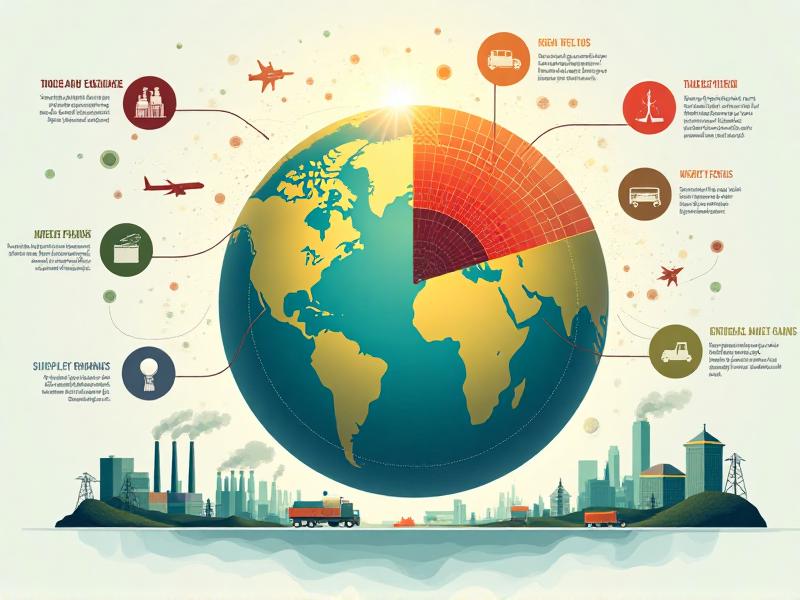Carbon Footprint of Commercial Operations
Understanding the Carbon Footprint of Commercial Operations
Commercial operations encompass a wide range of activities, from manufacturing and logistics to office management and retail. Each of these activities contributes to the carbon footprint, which is the total amount of greenhouse gases (GHGs) emitted directly or indirectly by an organization. Understanding the carbon footprint of commercial operations is crucial for businesses aiming to reduce their environmental impact and meet sustainability goals.
Carbon emissions in commercial operations are primarily generated through energy consumption, transportation, waste management, and supply chain activities. For instance, the energy used to power office buildings, factories, and retail stores often comes from fossil fuels, which release significant amounts of carbon dioxide (CO2) into the atmosphere. Similarly, the transportation of goods and services, whether by road, air, or sea, contributes to emissions through the burning of diesel, gasoline, and jet fuel.
Moreover, waste generated by commercial operations, if not managed properly, can lead to the release of methane, a potent greenhouse gas, from landfills. The supply chain, which includes the production and transportation of raw materials, also plays a significant role in the overall carbon footprint. Companies must consider the entire lifecycle of their products and services to accurately assess and mitigate their carbon emissions.

The Role of Energy Consumption in Carbon Emissions
Energy consumption is one of the largest contributors to the carbon footprint of commercial operations. Businesses rely on energy to power their facilities, run machinery, and maintain comfortable working environments. However, the source of this energy plays a critical role in determining the associated carbon emissions.
Most commercial energy consumption comes from electricity and heating, which are often generated from fossil fuels such as coal, natural gas, and oil. These energy sources release large amounts of CO2 when burned, contributing significantly to global warming. In contrast, renewable energy sources like solar, wind, and hydropower produce little to no carbon emissions, making them a more sustainable choice for businesses.
To reduce their carbon footprint, companies can adopt energy-efficient practices and technologies. For example, upgrading to energy-efficient lighting, HVAC systems, and appliances can significantly reduce energy consumption. Additionally, businesses can invest in on-site renewable energy generation, such as solar panels or wind turbines, to offset their reliance on fossil fuels. Implementing energy management systems and conducting regular energy audits can also help identify areas for improvement and track progress over time.

Transportation and Logistics: A Major Contributor to Carbon Emissions
Transportation and logistics are essential components of commercial operations, enabling the movement of goods and services from suppliers to customers. However, this sector is also a major contributor to carbon emissions, particularly due to the reliance on fossil fuel-powered vehicles.
The transportation of goods by road, air, and sea accounts for a significant portion of the carbon footprint in commercial operations. Trucks, ships, and airplanes burn large amounts of diesel, gasoline, and jet fuel, releasing CO2 and other pollutants into the atmosphere. The longer the distance traveled and the heavier the load, the greater the emissions.
To mitigate the environmental impact of transportation and logistics, companies can adopt several strategies. Optimizing supply chain routes to reduce travel distances, consolidating shipments to minimize the number of trips, and using more fuel-efficient vehicles can all help lower emissions. Additionally, businesses can explore alternative transportation methods, such as rail or electric vehicles, which have a lower carbon footprint. Investing in carbon offset programs, which fund projects that reduce or capture emissions elsewhere, can also help balance out the environmental impact of transportation activities.

Waste Management and Its Impact on Carbon Footprint
Waste management is another critical aspect of commercial operations that can significantly impact the carbon footprint. Improper waste disposal, particularly in landfills, leads to the release of methane, a greenhouse gas that is much more potent than CO2 in terms of its global warming potential.
Commercial operations generate various types of waste, including paper, plastic, food, and hazardous materials. When these materials are sent to landfills, they decompose anaerobically (without oxygen), producing methane as a byproduct. Methane emissions from landfills are a major contributor to climate change, and reducing them is essential for mitigating the carbon footprint of businesses.
To address this issue, companies can implement waste reduction and recycling programs. Reducing the amount of waste generated in the first place, through practices like source reduction and reusing materials, can significantly lower emissions. Recycling materials such as paper, plastic, and metal reduces the need for virgin resources, which often require energy-intensive extraction and processing. Additionally, composting organic waste can prevent it from ending up in landfills and producing methane. Businesses can also explore waste-to-energy technologies, which convert waste into usable energy, further reducing the environmental impact.
Supply Chain Sustainability: Reducing Emissions from Raw Materials to Finished Products
The supply chain is a complex network of activities that spans from the extraction of raw materials to the delivery of finished products to consumers. Each stage of the supply chain has the potential to contribute to the carbon footprint of commercial operations, making it a critical area for sustainability efforts.
Raw material extraction and processing are often energy-intensive processes that release significant amounts of CO2. For example, mining for metals, drilling for oil, and harvesting timber all require substantial energy inputs, often from fossil fuels. Additionally, the transportation of raw materials to manufacturing facilities and finished products to distribution centers further adds to the carbon footprint.
To reduce emissions in the supply chain, companies can adopt sustainable sourcing practices. This includes selecting suppliers that prioritize environmental responsibility, such as those that use renewable energy, minimize waste, and implement energy-efficient processes. Businesses can also work with suppliers to optimize transportation routes, reduce packaging, and improve overall supply chain efficiency. Furthermore, companies can invest in technologies that enhance supply chain transparency, allowing them to track and measure the carbon footprint of their products from start to finish. By taking a holistic approach to supply chain sustainability, businesses can significantly reduce their overall carbon emissions and contribute to a more sustainable future.
Corporate Responsibility and the Path to Net-Zero Emissions
As awareness of climate change grows, corporate responsibility has become a central focus for businesses worldwide. Many companies are now committing to achieving net-zero emissions, which means balancing the amount of greenhouse gases emitted with an equivalent amount of emissions removed or offset.
To achieve net-zero emissions, businesses must first measure their carbon footprint accurately. This involves assessing emissions from all aspects of their operations, including energy consumption, transportation, waste management, and supply chain activities. Once the baseline emissions are established, companies can develop a comprehensive strategy to reduce their carbon footprint through a combination of energy efficiency, renewable energy adoption, waste reduction, and sustainable sourcing.
In addition to reducing emissions, companies can invest in carbon offset projects, such as reforestation, renewable energy development, and methane capture, to neutralize any remaining emissions. Transparency and accountability are also crucial in this process. Businesses should regularly report on their progress towards net-zero goals and engage with stakeholders, including employees, customers, and investors, to build trust and support for their sustainability initiatives. By taking proactive steps towards net-zero emissions, companies can demonstrate their commitment to environmental stewardship and contribute to the global effort to combat climate change.








